VIRUS UPDATE: Positive cases in Xàbia continue to drop this week
The infection spread in the Marina Alta has dropped by almost a third in the last two weeks.
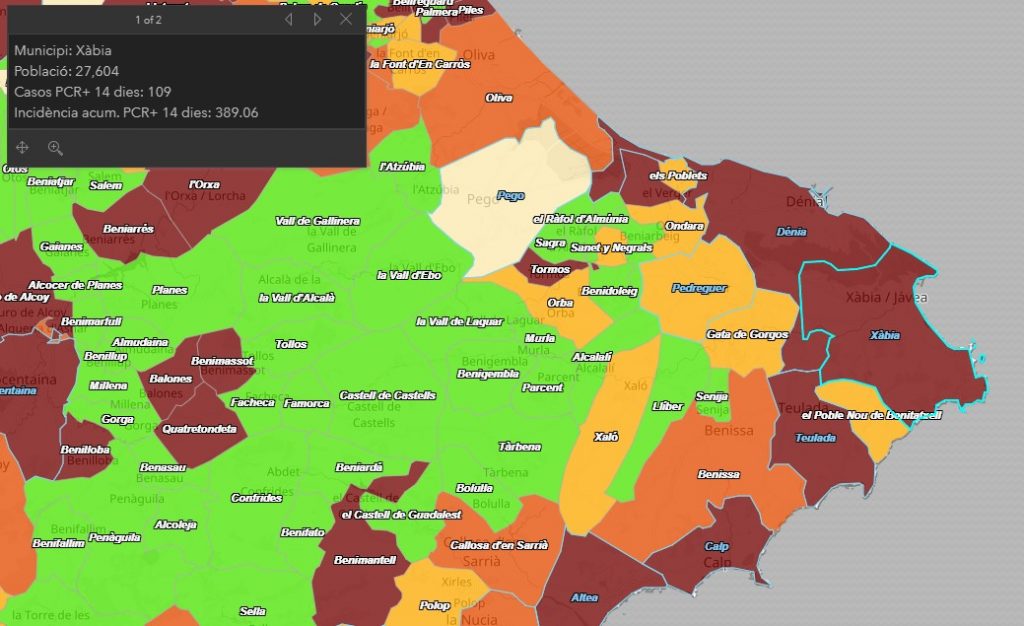
Friday 27th August 2021 – Compiled by MIKE SMITH
Xàbia
The total number of positive coronavirus cases detected by PCR test in Xàbia has climbed to 2,278, according to the latest update from the regional health ministry, an increase of 26 since the last update on Tuesday 22nd August and the lowest rise since early July.
The municipality’s 14-day IA rate, a measure of the speed at which the virus moves through the population, has dropped to 389.06 cases per 100,000 inhabitants and the town remains in the ‘Extreme Risk’ alert level.
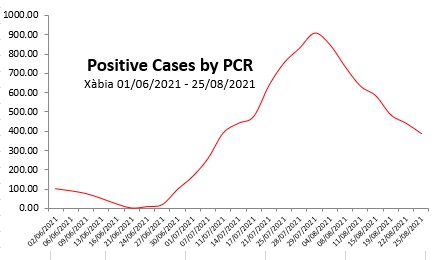
There have been no new deaths in Xàbia since late March and the number remains at 12.
Marina Alta
There have been 443 new positive cases detected by PCR test in the Marina Alta in the past 14 days and the region’s 14-day IA rate has dropped to 259.63 cases per 100,000 inhabitants and it remains in the ‘Extreme Risk’ alert level. The detection of positive cases of COVID-19 in the region has dropped by 35% in the past two weeks.
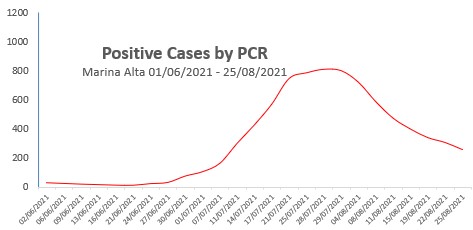
There have been 0 new deaths since the last update and the region’s toll remains at 205.
The total number of positive cases since the pandemic began is now 14,274 since the last update on Tuesday 22nd August, a rise of 144.
- 58 – Dénia
- 26 – Xàbia
- 15 – Calp
- 12 – Teulada-Moraira
- 11 – Benissa
- 9 – El Vergel
- 4 – Ondara
- 3 – Pedreguer
- 2 – Tormos
- 1 – Gata de Gorgos; Orba; Pego; el Poble Nou de Benitatxell.
Municipalities at EXTREME RISK level
Calp; Dénia; El Vergel; Teulada-Moraira; Tormos; Xàbia.
Municipalities at HIGH RISK level
Benissa; Sanet y Negrals.
Municipalities at MEDIUM RISK level
Els Poblets; Gata de Gorgos; Ondara; Orba; Pedreguer; el Poble Nou de Benitatxell; Xaló.
Municipalities at LOW RISK level
Pego.
Autonomous Regions at NEW NORMAL level
Adsubia; Alcalalí; Beniarbeig; Benidoleig; Benigembla; Benimeli; Castell de Castells; Llíber; Murla; Parcent; el Ràfol d’Almúnia; Sagra; Senija; la Vall d’Ebo; la Vall de Lagaur; la Vall de Gallinera.
Spain
Spain’s 14-day IA rate is 276.43 cases per 100,000 inhabitants, a drop of more just over 23% in the last week, but the country remains in the ‘Extreme Risk’ category.
The Positivity Rate, the measure of how many coronavirus tests return positive, has dropped to 10.37%. A value of 5% or less indicates that transmission of the virus is more or less under control.
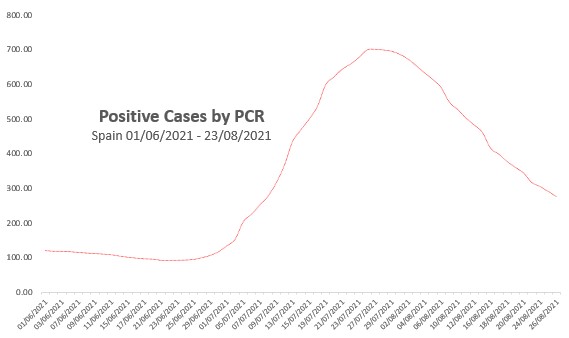
Hospitalizations
According to the latest report from the CCAES, there are 7,368 hospitalized due to COVID-19 across Spain, a drop of more than 22% on two weeks ago, of which 1,701 have been admitted to ICU wards, a drop of 11.45% on two weeks ago. The percentage of beds in general wards occupied by patients suffering from COVID-19 is 6.29% whilst the percentage of beds in ICU wards occupied by COVID-19 patients is 18.04%, both lower than two weeks ago.

Cataluña still leads the way in hospitalizations, with 1,538 people currently in hospital due to COVID-19, of which 36.78% have been admitted to ICU wards for extreme cases. The autonomous region of Madrid is just behind, with 1,563 people in hospital, of which 31.98% are in ICU wards, whilst Andalucia has 1,098 people in hospital, 11.40% of which are being cared for in ICU wards.
In the Comunidad Valenciana, 476 people are currently hospitalized, according to the latest CCAES report, with 13.40% of ICU ward capacity occupied by those suffering from the extreme effects of COVID-19.
Deaths
The country has suffered 352 deaths in the past seven days, a rise of just over 12% when compared to two weeks ago. This appears to be the normal progress of the infection spread: positive cases rise, then hospitalizations increase, and finally the number of deaths increase. This can clearly been seen in the three charts given in this summary for Spain.
The national death toll rises to 83,861 since the pandemic began.
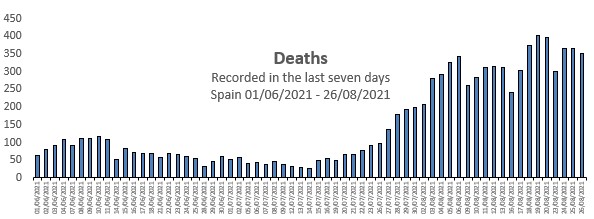
Regional Data
Across Spain, the rise of infections continues to slow with all but one of the 19 autonomous regions have reported IA rates lower than they were two weeks ago. The North African enclave of Ceuta (559,00) is, again, the odd one out with a 32% rise in infections in a fortnight but this has been attributed to the fact that 67 of the 223 new cases diagnosed in the last seven days corresponding to outbreaks in migrant reception centres in the city.
Behind Ceuta, just two regions remains above 400: Extremadura (490.98), and the autonomous city of Melilla (413.43).
At the other end of the scale remains Asturias (116.51) with the Canarias on 183.92.
The Comunidad Valenciana’s rate, currently 221.10, has almost halved in the past two weeks and it remains the autonomous region with the second lowest rate in mainland Spain behind Asturias. All health departments in the region has seen positives cases drop for the first time since mid-March. On average, infection spread has decreased by 36% in two weeks.
Autonomous Regions at EXTREME RISK level
Andalucia; Aragón; Baleares; Cantabria; Castilla y León; Castilla-La Mancha; Cataluña; Ceuta; Extremadura; Galicia; La Rioja; Madrid; Melilla; Murcia; Navarra; País Vasco.
Autonomous Regions at HIGH RISK level
Canarias; Comunidad Valenciana.
Autonomous Regions at MEDIUM RISK level
Asturias.
Autonomous Regions at LOW RISK level
None
Autonomous Regions at NEW NORMAL level
None
The newspaper El Pais has reported that the so-called ‘fifth wave’ of the pandemic in Spain set a new daily high this week with 190 COVID-19-related deaths on Tuesday, although this is well below what was seen during the ‘first wave’ when more than 800 daily death were reported. A rising death toll is the last indicator that starts to rise during each wave and it is also the last to start to fall.
How does Spain compare to the rest of Europe?
Top 20 table based on new confirmed COVID-19 cases per 1 million population on August 26th 2021.
- Kosovo (1,031.38) ↓
- Montenegro (998.99) ↑
- United Kingdom (499.58) ↑
- North Macedonia (478.14) ↓
- Republic of Ireland (375.79) ↑
- Cyprus (324.00) ↓
- Greece (317.24) ↑
- France (297.80) ↓
- Switzerland (294.06) ↑
- Serbia (276.66) ↑
- Monaco (236.62) ↑
- Estonia (235.20) ↑
- Albania (231.13) ↑
- Turkey (229.56) ↑
- Portugal (228.31) ↓
- Iceland (220.62) ↓
- Lithuania (216.57) ↑
- Bulgaria (200.11) ↑
- Spain (196.52) ↓
- Liechtenstein (194.79) ↓
↑ = infection spread trend rising
↓ = infection spread trend dropping
Source: ourworldindata.org
Vaccination (25.08.21)
Spain has administered 64,714,501 doses of vaccine, which is 90.2% of those which it has already received (71,756,402). A total of 32,239,782 people have completed the recommended course, which is 76.5% of the total of the population which is to be vaccinated (42,119,827) or 67.9% of the total population of Spain.
According to the latest data provided by the health authorities, 94.0% of people aged 40 and over in Spain have received at least one dose, with 91.7% having completed the recommended course.
The Comunidad Valenciana has administered 6,872,586 doses of vaccine, which is 90.2% of the total which it has received (7,620,680). A total of 3,358,717 people have completed the recommended course, which 74.8% of the population which is to be vaccinated (4,488,459) or 66.4% of the total population of the Comunidad Valenciana.
According to the latest data provided by the health authorities, 94.7% of people aged 40 and over in the Comunidad Valenciana have received at least one dose, with 92.3% having completed the recommended course.
The newspaper El Pais has reported that Spain’s Health Minister, Carolina Darias, has suggested that a third dose of COVID-19 vaccine could be administered to ‘at-risk’ groups once the European Medicines Agency has granted permission to do so, which it taking a lot longer than expected.
The newspaper has also reported that there are more than 7.8 million doses of COVID-19 vaccine in storage in Spain, due partly to the decreasing rhythm of the vaccination campaign across the country during the peak holiday season as well as the mass arrival of new vials, mostly from Pfizer.
How does Spain compare to the rest of Europe?
Top 20 table based on percentage of total population fully vaccinated.
- Malta (79.78%)
- Iceland (77.05%)
- Portugal (72.84%)
- Denmark (70.63%)
- San Marino (70.56%)
- Belgium (68.40%)
- Spain (68.29%)
- Republic of Ireland (66.37%)
- Netherlands (62.20%)
- United Kingdom (61.98%)
- Italy (59.08%)
- Germany (58.97%)
- Austria (57.10%)
- Hungary (56.98%)
- Cyprus (56.78%)
- France (56.67%)
- Luxembourg (56.27%)
- Greece (54.38%)
- Lithuania (53.85%)
- Liechtenstein (53.63%)
Source: ourworldindata.org
LINKS
- Actualización nº 449. Enfermedad por el coronavirus (COVID-19). 26.08.2021
- GIV COVID-19 Gestión integral de la vacunación COVID-19
- COVID-19 C. Valenciana: Monitoratge de la situació



